

In this rapidly growing digital era, innovation in software quality assurance (QA) has reached unprecedented heights. Ajay Seelamneni, a researcher passionate about AI-enhanced software testing, brings some of the most groundbreaking advancements in automated QA. His insights outline a new frontier where artificial intelligence fundamentally transforms how we validate and sustain software integrity.
The journey of software QA has moved far beyond manually checking lines of code or visually inspecting user interfaces. Though a step ahead of manual testing, traditional automation frameworks struggled with maintenance and adaptability. AI’s emergence in QA represents not just an improvement but a paradigm shift enabling systems to predict, adapt, and evolve with the software they test.
By integrating AI into QA workflows, organizations have reported up to a 35% reduction in test maintenance and a 30% boost in defect detection accuracy. These aren’t minor gains—they’re industry-altering improvements that set new benchmarks in how software gets shipped.
Creating compelling test cases used to demand considerable manual labor. Now, AI-driven tools generate tests based on user behavior, historical defect data, and code structure analysis. These intelligent systems can achieve up to 92% precision in identifying defect-prone modules, dramatically cutting down the time spent writing and updating test cases.
Natural Language Processing (NLP) has emerged as a key enabler, converting textual requirements into executable tests. Deep learning models recognize complex usage patterns, enabling broader test coverage and more thorough validation. Platforms leveraging graph-based neural networks have demonstrated 65% more efficiency in detecting hidden interaction errors than traditional methods.
In dynamic development environments, constant UI changes often break existing test scripts. AI addresses this with self-healing test frameworks that identify broken elements and adapt execution paths autonomously. Leveraging algorithms like random forests and reinforcement learning, these systems maintain high accuracy even after substantial UI modifications.
These self-healing capabilities have proven transformative. Organizations reported an average 52.7% reduction in maintenance efforts and a 71% decline in false test failures. Such adaptability enables faster release cycles and restores stakeholder confidence in automation reliability.
Another area where AI shines is in predicting defects even before they manifest. Using machine learning algorithms trained on historical code and defect data, predictive QA models can flag risky code changes with up to 86% accuracy. This "shift-left" approach means issues are resolved earlier—when fixes are faster and less expensive.
Tools like SonarQube now integrate AI to enhance static analysis by enriching code metrics with contextual data. Combined with gradient boosting models, these setups offer over 80% precision in detecting critical errors such as null pointer exceptions and resource leaks. For teams working in microservices or distributed environments, AI has unlocked the ability to pinpoint cross-component defects that traditional methods miss.
Visual inconsistencies in software, such as misaligned buttons or broken layouts, are a major source of poor user experience. Conventional testing often overlooks these because it focuses more on functionality than appearance. AI is closing this gap through computer vision.
Using perceptual hashing, deep learning, and layout modeling, AI visual testing platforms now mimic human perception. They can distinguish meaningful UI changes from harmless cosmetic ones, reducing false positives by over 50%. With the integration into CI pipelines, visual issues are now detected up to 3.5 times earlier—boosting both release speed and interface quality.
AI implementation for QA is not a simple insertion into an autonomous environment. Clean and complete data sets have to be collected followed by architectural design and phased implementation. Roadblocks are poor historical data, integrating into existing pipelines, and resistance to organizational change.
Pilot programs, centralized knowledge hubs for AI, and investment in upskilling QA teams are some of the successful cases that attest to this need. It is intended to scale through test generation, then self-healing automation, and eventually through predictive analytics, so that there is momentum going along, yet there would be very little disruption to the business.
AI is revolutionizing the domain of quality assurance with federated learning across organizations, retaining privacy throughout the training. Multimodal systems fuse text, visuals, and behavior. Conversational interfaces allow a client to test simple inputs in plain language. Independent QA systems are on the rise, detecting defects by themselves and fixing them, which paves the way for intelligent self-sufficient test frameworks of tomorrow.
Hence, the work by Ajay Seelamneni presents a very futuristic approach to the AI transformation of QA. With the introduction of AI technologies referring to test creation, test execution, and test maintenance conjointly with predictive and perceptual intelligence, the AI revolution is transforming QA from a reactive toward a proactive and agile aspect of today's software development. Considering the increasing complexity of digital systems, these advancements are not an option anymore but a requirement to facilitate quality at scale.
